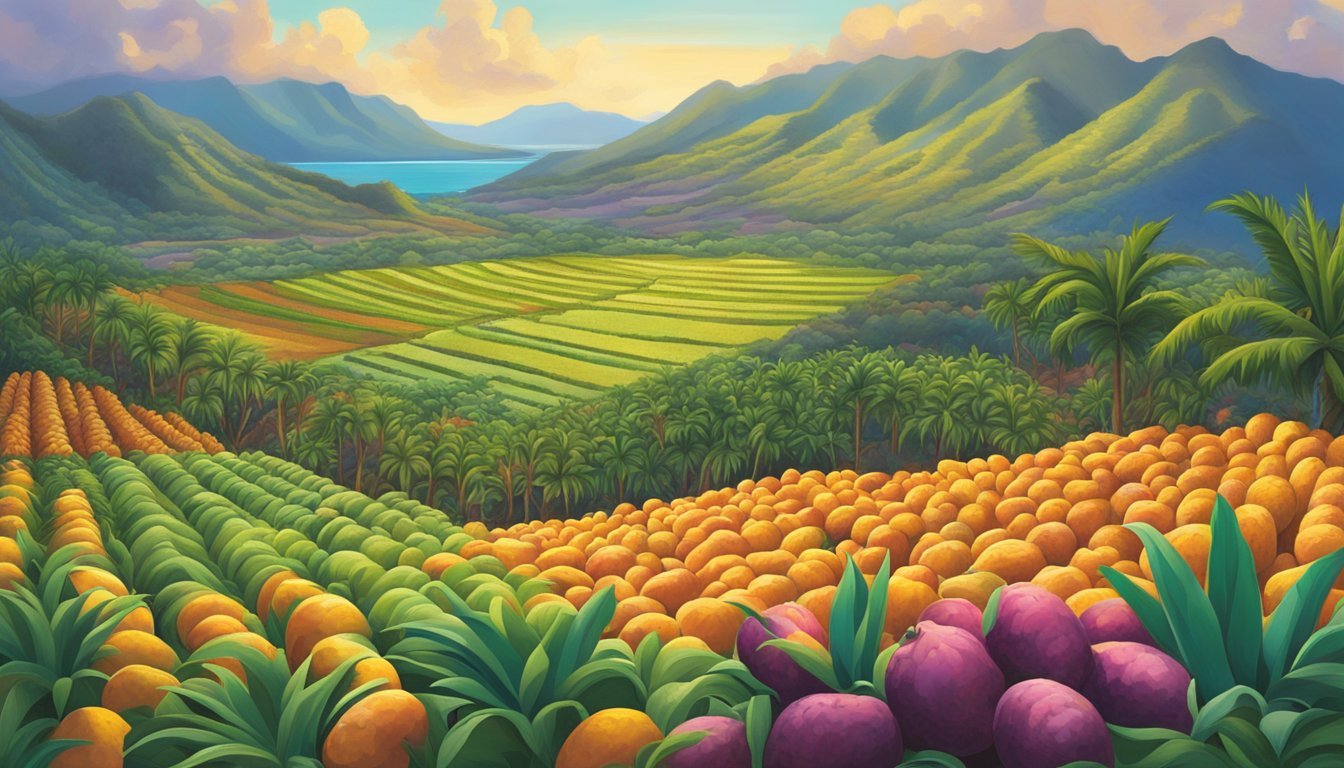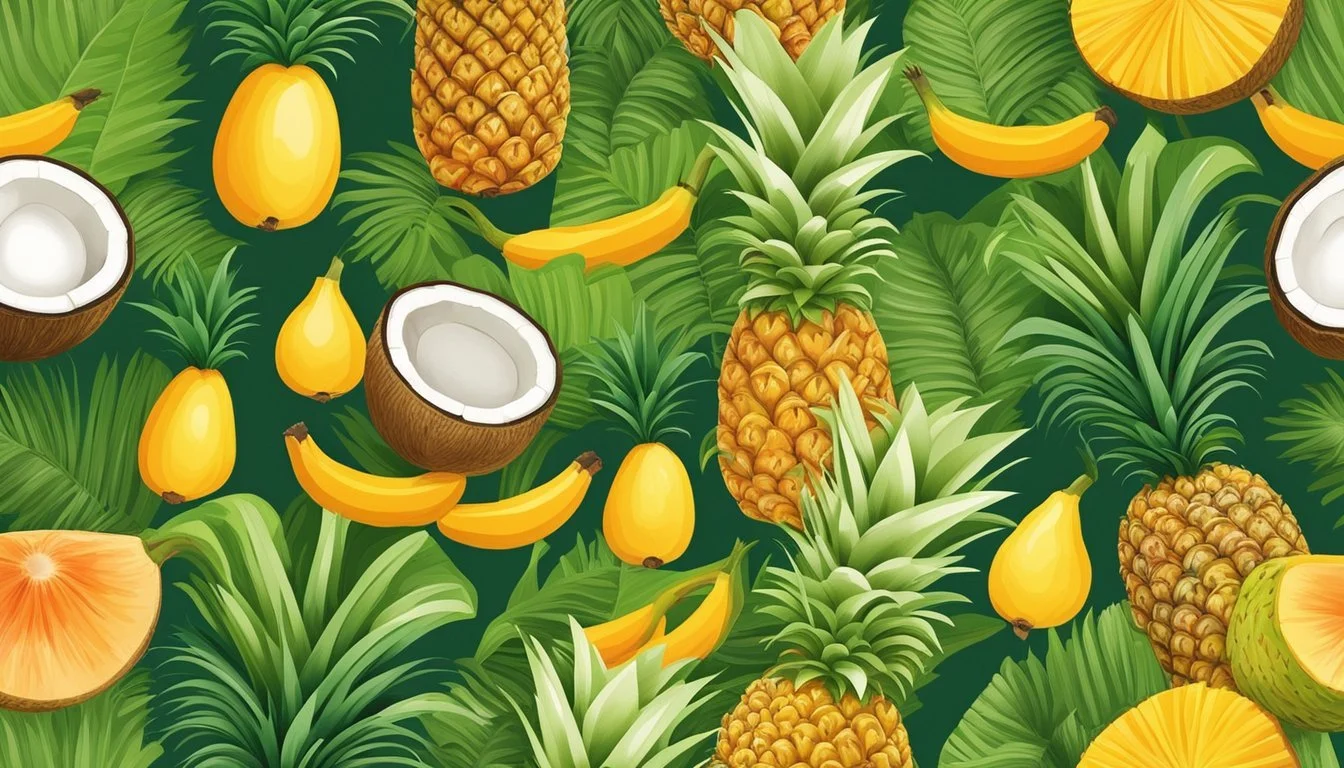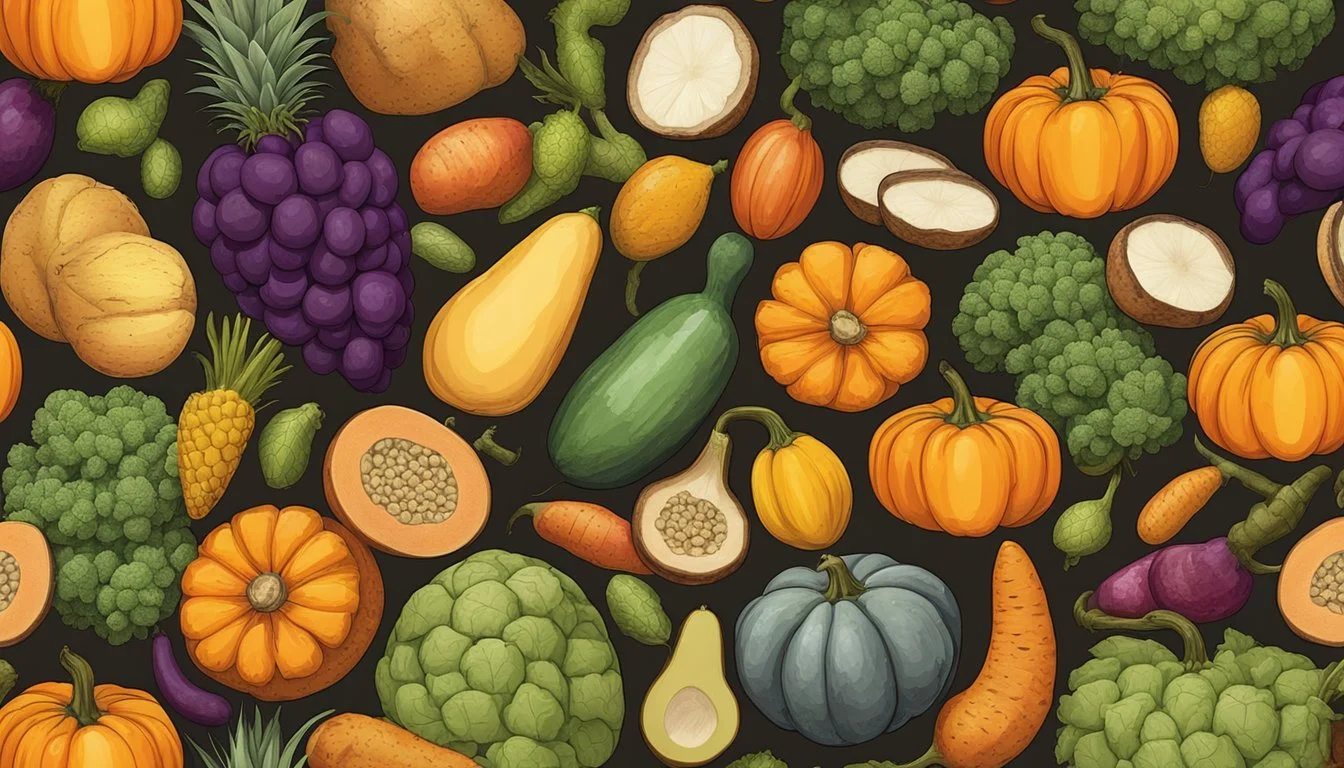Hawaii Seasonal Fruit & Vegetables in November
A Guide to Fresh Produce
This Article is Part of our Hawaii Seasonal Fruit & Veg Calendar
Hawaii enjoys a lush, tropical climate that fosters the growth of a wide array of fruits (What wine goes well with fruit?) and vegetables year-round. The islands' fertile volcanic soil and warm weather provide an environment where produce not only thrives but also offers peak freshness and flavor. In November, the range of seasonal produce available in Hawaii is varied, with both exotic fruits and hearty vegetables being harvested during this time.
Visitors and residents alike can indulge in November's bounty which includes staples such as sweet potatoes (What wine goes well with sweet potatoes?), ginger, and an assortment of greens. The fruit selection is particularly remarkable; the tail end of mango season yields its final, juicy offerings, and the lychee crops, which are usually at their best from May, can sometimes extend their presence into November.
Among the diverse selection, one can also find avocados, bananas (how long do bananas last?), and the renowned Hawaiian staple, taro. This period marks an overlap of seasons, where the last of the summer fruits meet the initial harvests of winter, creating a unique blend of flavors that capture the essence of Hawaii's agricultural landscape.
Overview of Hawaii's Seasonal Produce
In November, Hawaii's seasonal produce provides a unique window into the island's diverse agricultural offerings, showcasing a blend of tropical fruits and vegetables that thrive during the islands' mild winter season.
Seasonal Shifts and Their Impact
As November unfolds, Hawaii experiences subtle seasonal shifts rather than drastic temperature changes. The cooler and wetter weather of the Hawaiian winter marginally affects the growing season, allowing for the harvest of both year-round staples and some seasonal specialties. Certain tropical fruits reach peak availability, while a variety of vegetables are harvested just in time for winter.
Fruits Often Harvested in November:
Avocados: Ripe and rich, available in several varieties.
Bananas: Continuously available, an island favorite.
Mangoes: Tail end of their season, still found ripe.
Papayas: Year-round production, with peak seasons including winter.
Passion Fruit (Lilikoi): The end of their prime season, still juicy and aromatic.
Vegetables Commonly Available in November:
Lettuce: Cool weather supports lush growth.
Kale: Hardy green, well-suited for Hawaii's winter.
Cabbage: Thrives in the slightly cooler temperatures.
Root vegetables such as sweet potatoes and carrots are often dug up this time of the year, sweeter as the soil cools.
Hawaii's Unique Agricultural Environment
Hawaii's agricultural environment benefits from fertile volcanic soil and varied microclimates, leading to a year-long growing season. This allows farmers to produce a wide variety of products that are less impacted by the colder months. Irrigation advancements and traditional practices also contribute to successful winter harvesting.
Fruit Production: Due to Hawaii's microclimates, fruit trees can bloom and bear fruit through different times of the year, with some adapting to the cooler winter months.
Vegetable Growth: Vegetables in Hawaii are generally less susceptible to the seasonal shift to winter, enabling farmers to continue growing a range of crops without significant interruption.
The synergy between the unique climate and rich soil in Hawaii results in a bounty of produce that graces the winter months. November, with its gentle transition into cooler weather, still promises an impressive harvest that sustains island cuisine and exports.
Seasonal Fruits Available in November
November in Hawaii offers a delectable variety of fruits as the island's tropical climate maintains a year-round growing season for many varieties.
Tropical Abundance
Pineapple, a symbol of Hawaii's agricultural heritage, is available year-round but continues to be plentiful in November. Bananas, including the common Cavendish as well as Hawaiian apple bananas, also grace the markets during this month with their sweet, robust flavors. While mango and lychee are not in season, other fruits like rambutan and starfruit make their appearance, providing an exotic flair to the fruit selection.
Citrus and Other Fruit Varieties
In addition to tropical fruits, November sees the beginning of citrus season in Hawaii. Varieties such as tangerines and lemons start to become available. Other fruits that one might find include guava and lilikoi (passion fruit), both are known for their fragrant aroma and tangy taste.
Guava: Common in backyards and wild in the forests, it's usually harvested in late summer and fall.
Lilikoi (Passion Fruit): Known for its unique flavor, often available towards the end of the year.
It should be noted that papayas are available throughout the year, so consumers can continue to enjoy this sweet, tropical fruit in November as well.
Seasonal Vegetables to Look For
In Hawaii, November offers an abundance of diverse vegetables due to the year-round growing season. Shoppers can find an array of fresh, flavorful produce that ranges from hearty root vegetables to vibrant leafy greens.
Root Vegetables and Squash
Sweet Potatoes: These nutritious tubers are a staple in November and can be found in a variety of colors, from orange to purple.
Taro: Often used in traditional Hawaiian dishes, taro is a versatile vegetable with a rich cultural history.
Potatoes: A variety of potatoes are available and are perfect for a range of culinary applications.
Leafy Greens and Other Vegetables
Cabbage: Cabbage is crisp and fresh in November, ideal for salads and slaws.
Lettuce: There is an ample supply of lettuce, providing a fresh, crunchy base for salads.
Beans: Green beans are at their peak, snappy and tender for side dishes.
Cucumbers: These are refreshing, whether pickled or used fresh in salads.
Celery: (how long does celery last?) Celery stalks are crisp and perfect for adding a crunchy texture to dishes or enjoying as a raw snack.
Harvesting and Availability
In November, various fruits and vegetables reach their prime harvesting time in Hawaii, leading to an increase in availability both at local farmers markets and grocery stores.
Peak Harvest Times
Bananas and papayas are typically in abundance as they can be harvested year-round. November is particularly a peak season for macadamia nuts and coffee beans, with harvesting in full swing. Sweet potatoes also tend to reach their peak around this time, right before Hawaii's wetter months set in. Shoppers can expect:
Bananas: Continuous harvesting
Papayas: Harvested throughout the year
Macadamia Nuts: Peak harvest
Coffee Beans: Prime harvesting season
Sweet Potatoes: Optimal harvest time
Understanding Availability at Markets
Farmers markets often have the freshest selection since many local producers bring their goods directly after harvest. Seasonal factors influence the availability of products such as persimmons and guavas at these markets. Grocery stores also stock these items but may source from a wider geographic area, impacting freshness. Consumers should note:
Farmers Markets: Likely to offer the freshest seasonal produce
Grocery Stores: Broader sourcing, which may affect product freshness
Preparing Seasonal Produce
In November, Hawaii offers a bounty of fresh, flavorful produce that can elevate any meal with their natural sweetness, tartness, and vibrant colors. Cooking with these ingredients not only supports local agriculture but ensures that meals are prepared with the most nutritious and tasteful options available.
Culinary Uses for Fruits
Apple Bananas: Their sweet flavor with hints of apple makes them perfect for desserts and smoothies. They can be eaten raw, baked into banana bread, or mashed into pancakes.
Coconut: Fresh coconut milk and coconut water can be used to infuse tropical flavors into dishes. Coconut milk enriches curries and desserts, while coconut water is excellent for hydrating drinks and smoothies.
Limes: Adding a tart zing to both sweet and savory dishes, limes are commonly used in marinades, beverages, and to finish off dishes with a fresh burst of citrus.
Mangoes: With their rich, sweet flavor, mangoes are versatile in the kitchen. They are excellent in jams, jellies, and juices, and can also be used in savory applications like salsas.
Papayas: Papayas can be eaten fresh or used to tenderize meats due to their enzymes. Their sweet, musky taste pairs well with acidic dressings in fruit salads.
Culinary Uses for Vegetables
Green Onions: They are flavorful in both raw and cooked forms, offering a sharp yet not overpowering taste to salads, soups, and garnishes.
Lettuce: From salads to sandwiches, the various types of lettuce add crunch and freshness to meals. They form the base for salads that can be accentuated with other seasonal fruits and vegetables.
Taro Leaves (Luau): When cooked, they become tender and are often used in traditional Hawaiian dishes, such as laulau, where they are wrapped around meats and steamed.
Sweet Potatoes: Their sweetness is enhanced when roasted or baked. They can be made into a mash, used in soups, or cut into wedges as a healthier alternative to French fries.
Cultural Significance of Seasonal Produce
Seasonal produce in Hawaii is interwoven with the islands' cultural fabric, playing a pivotal role in traditions and local cuisine. From the luau feasts to everyday meals, fruits and vegetables from the season mark festivities and flavor profiles unique to the region.
Fruits in Hawaiian Traditions
In Hawaii, tropical fruits such as mango, papaya, and pineapple are more than just food; they are integral to the island's cultural identity. Mango, for instance, is a local favorite that can be found in various traditional dishes and sweet treats. It is often celebrated in community festivals that underscore its cultural importance. Luaus, the Hawaiian feast synonymous with celebration, prominently feature fruits as part of their spread, showcasing the seasonal abundance and highlighting their role in hospitality and communal gatherings.
Vegetables in Local Cuisine
Hawaiian cuisine showcases vegetables in various dishes that highlight their fresh, vibrant flavors. Taro, for example, is a staple root vegetable turned into poi, a traditional Hawaiian dish with a significant cultural history. Beyond poi, taro leaves are also used to wrap and cook food, adding a distinctive taste to dishes indicative of the regional palate. Vegetables are sourced locally, maintaining the connection between the land, its bounty, and the Hawaiian people, further solidifying their place in the islands' culinary traditions.
Agricultural Practices in Hawaii
Hawaii's agricultural practices are a blend of traditional methods and modern sustainability. With a focus on enriching the soil and protecting the archipelago's diverse ecosystem, farmers emphasize both organic farming and the importance of local agriculture.
Organic and Sustainable Farming
Farmers in Hawaii often employ organic and sustainable farming techniques to cultivate their crops. These practices include the use of composting and natural pest management strategies that eschew synthetic pesticides and fertilizers. Crop rotation and cover cropping are also common, helping to maintain soil health and reduce erosion. On island farms, you’ll find an abundance of organic tropical crops such as fruits, herbs, and vegetables, which benefit from the fertile volcanic soil and favorable climate.
Importance of Local Farming
Local farming in Hawaii plays a vital role in supporting the state's economy and food security. By purchasing from local farms, consumers ensure that their food dollars stay within local communities. This not only helps small-scale farmers sustain their operations but also reduces the carbon footprint associated with long-distance transportation of produce. The Farm-to-Table movement is particularly strong in Hawaii, where the connection between the land, or 'ʻāina', and its people is deeply valued.
Local farming also fosters agricultural resilience which is crucial given Hawaii's isolation and susceptibility to supply chain disruptions. Diverse crops, including native varieties, are grown year-round, providing Hawaiians with a steady supply of fresh, nutrient-rich foods.
Shopping and Supporting Local
When exploring the vibrant food scene of Hawaii in November, one finds an abundance of local markets teeming with seasonal produce. Shoppers are encouraged to engage with the community by visiting farmers' markets across the islands. By doing so, they not only procure the freshest ingredients but also contribute to the sustainability of Hawaii's agricultural heritage.
Farmers' markets play a crucial role in Hawaii's economy, allowing farmers to sell directly to consumers. These markets are a feast for the senses, offering a variety of fruits and vegetables distinctively grown in Hawaii's unique volcanic soil.
Here are some November seasonal highlights to look out for:
Fruits:
Persimmons
Passion fruit
Bananas
Vegetables:
Sweet potatoes
Cabbage
Consumers benefit from nutrient-rich, flavorful produce that hasn't journeyed long distances. This practice not only supports the local agriculture but also reduces the carbon footprint associated with transporting goods.
Tips for shopping local:
Bring reusable bags to reduce plastic use.
Shop early for the best selection.
Ask farmers about cooking tips for unfamiliar produce.
Payment options vary, with many vendors accepting cash and sometimes credit cards. It's advisable to carry small denominations to make transactions smoother.
Ultimately, by choosing to shop local, individuals take part in a larger movement of environmental stewardship and community support. They ensure that the food on their table encapsulates the essence of Hawaii, both in taste and spirit.
Fruit and Vegetable Glossary
In Hawaii, each month brings a shift in the variety of produce available. November is no exception, offering a selection of fruits and vegetables that reflect the diversity and agricultural richness of the islands. The glossary below will discuss exotic and native varieties that are typically harvested during this time.
Exotic and Native Varieties Explained
Apple Banana: This small, sweet variety of banana is characterized by its apple-like flavor. It is denser and richer in taste compared to the more common Cavendish banana.
Mountain Apple: A native Hawaiian fruit, the mountain apple, or ‘ōhi‘a ‘ai, has a crisp texture and a flavor that resembles both apples (how long do apples last?) and pears. This bell-shaped fruit is often deep red or pink in color.
Strawberry Guava: An exotic fruit with a smooth, pink to red skin and creamy white interior. Its flavor is a unique combination of guava and strawberries, and it is a common wild fruit in Hawaii, although not originally native to the islands.
Pirie: Known also as the 'Pirie' mango, this variety is recognizable by its small size and sweet, aromatic flesh. November may see the last of the season for this tropical delight.
Passion Fruit: In Hawaii, the passion fruit is also referred to as liliko‘i. This tropical fruit is round and about the size of a tennis ball with a tough outer rind. Inside, it contains a jelly-like pulp with numerous seeds, having a tart, aromatic taste that is highly prized in culinary uses.
Please note that availability of fruits and vegetables can vary based on factors such as weather conditions and specific growing regions within Hawaii.
Conclusion
November in Hawaii offers an abundance of fresh produce, showcasing the island's ability to grow a variety of fruits and vegetables even as the year winds down. Visitors and locals alike have the opportunity to indulge in seasonal delights that are characterized by their freshness and quality.
During this month, mangoes remain a popular fruit with their sweet and tropical flavors, ripe for the picking until November's end. The Hawaiian orange, another local favorite, enters its season, providing a juicy and tangy option that is both refreshing and nutritious.
Those interested in more exotic flavors can enjoy the last of the rich and creamy lychee harvest or the unique tartness of the lilikoi (passion fruit). For vegetable enthusiasts, fresh luau leaves may still be found, commonly used in traditional Hawaiian dishes.
Here is a brief list of select produce to look out for:
Fruits: Mango, Orange, Lychee, Lilikoi
Vegetables: Luau Leaf
Farmers markets around the islands are vibrant places to find these seasonal goods, supporting local agriculture and promoting a sustainable food culture unique to the region. As the year moves closer to the winter season, the variety of produce will shift, so it is encouraged to take advantage of November's offerings.












